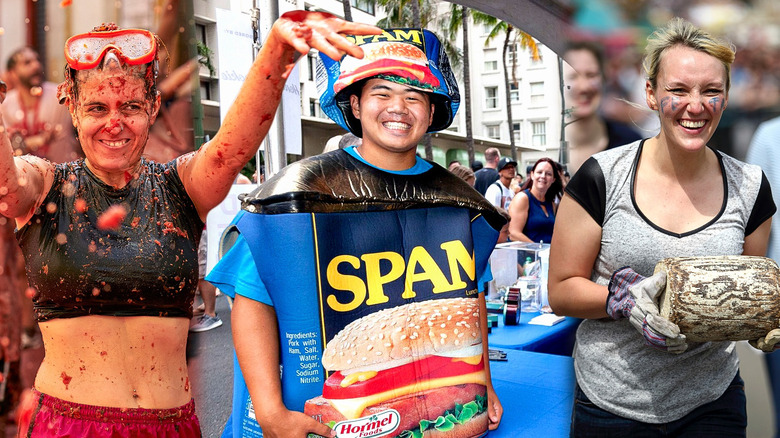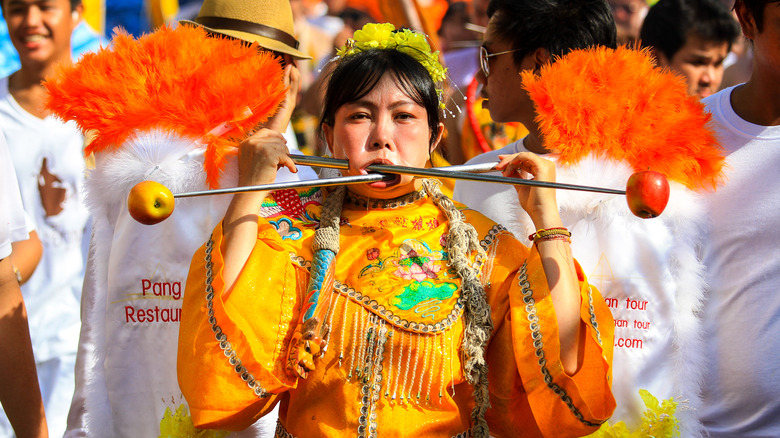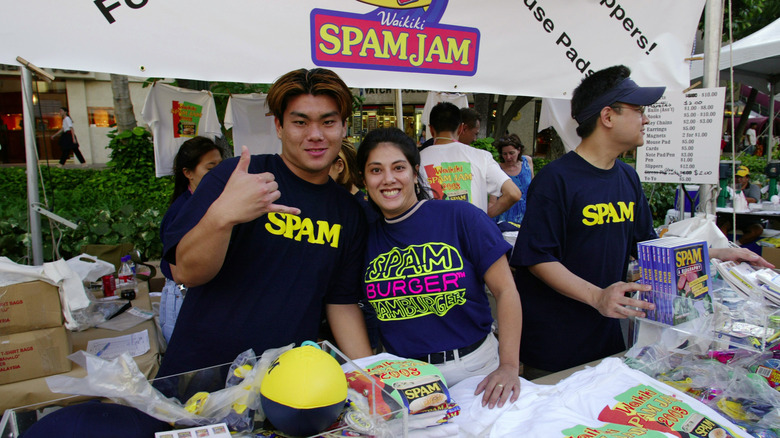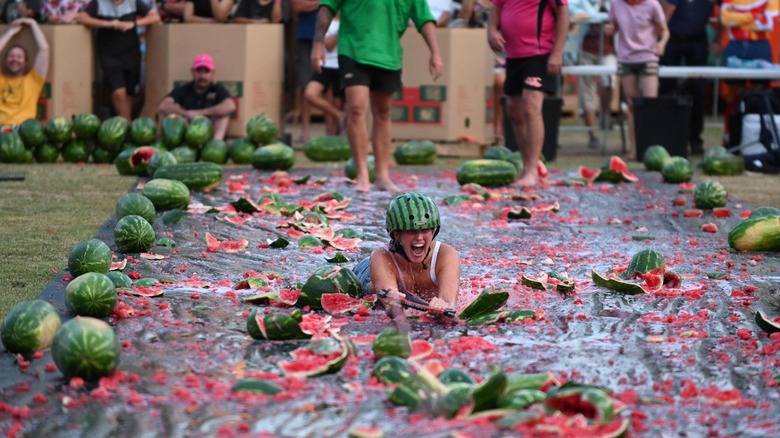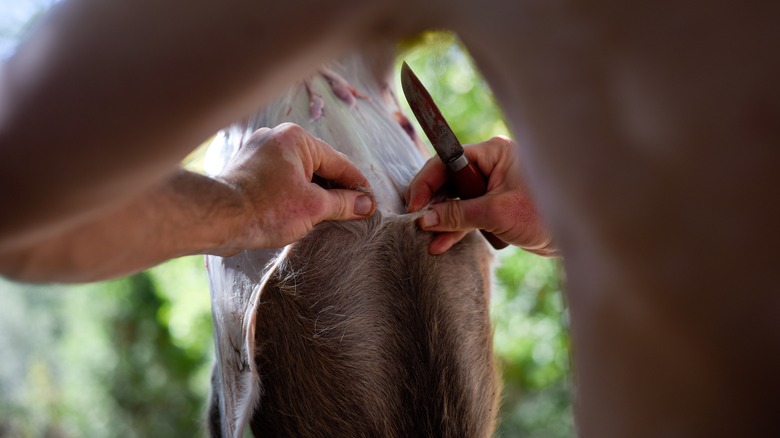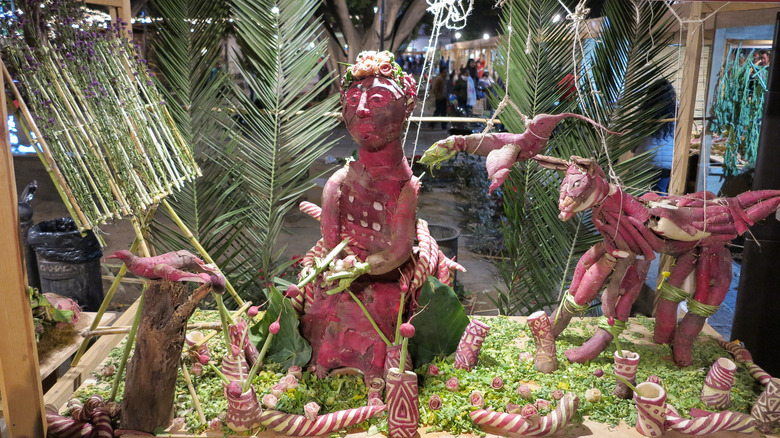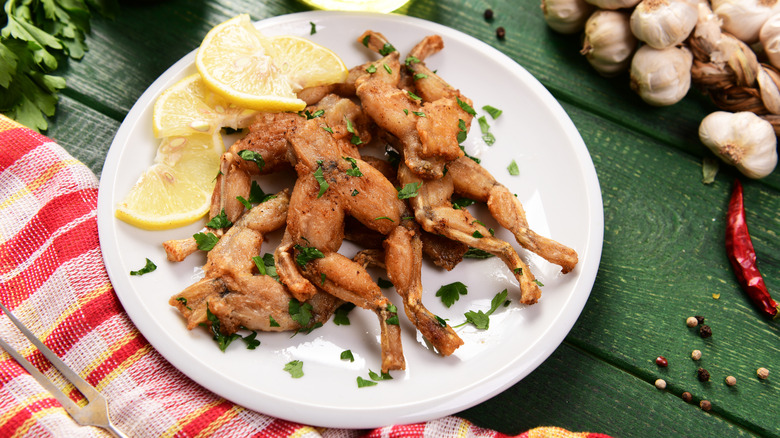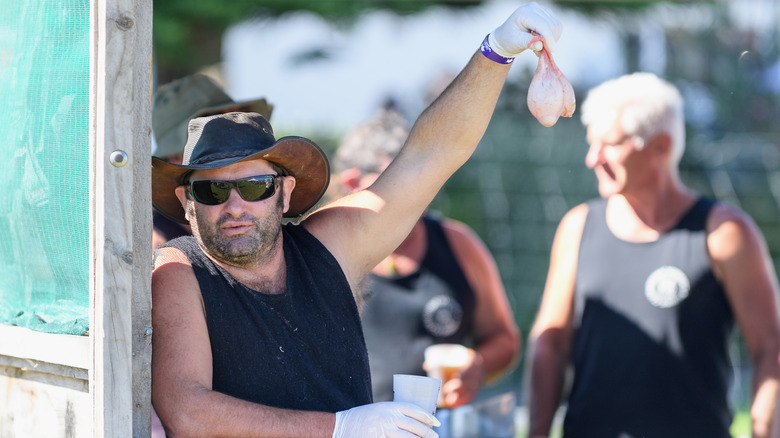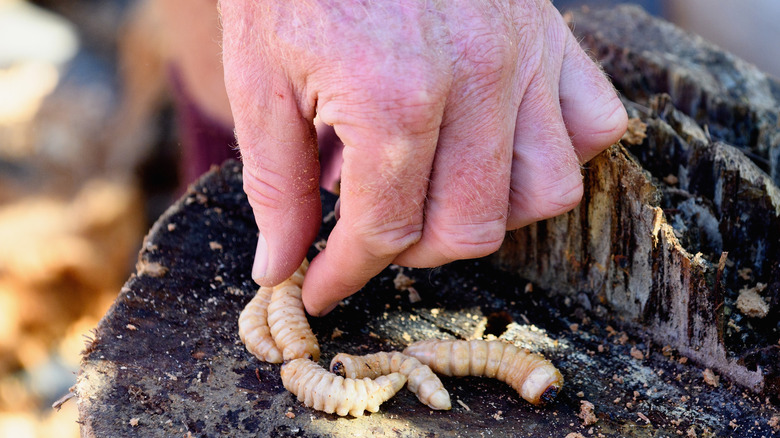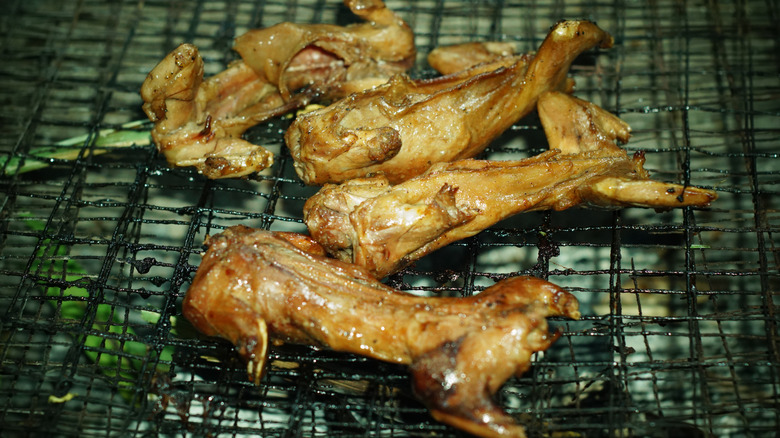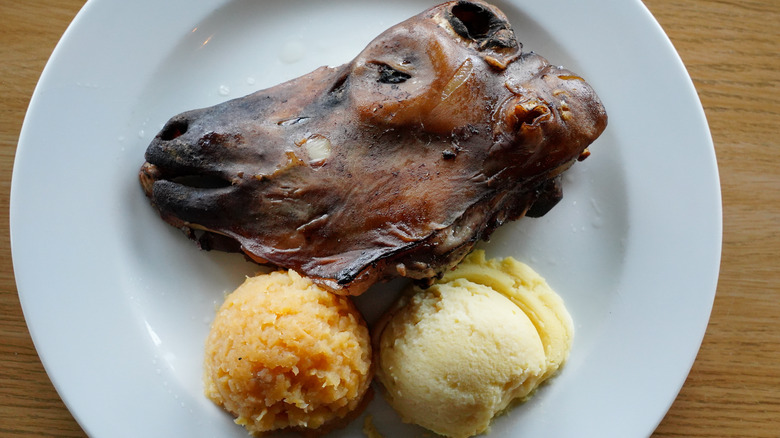Strange Food Festivals You Should Only Visit If You Are Adventurous
Food isn't just about taste. It's a full sensory experience. A food's origins, how it's cooked, and how it combines with other ingredients all create what can be dramatic visuals and flavor. Food can be plentiful and traditional, minimalist and gourmet, and also weird and wonderful. Dishes might reimagine classics, fuse culinary traditions, or completely surprise you. Ultimately, food can be a culinary adventure that can take you on a wild ride.
If you're open to trying new foods that you're unlikely to see on a restaurant menu, then a festival is a great way to go. If you're feeling especially daring, then seek out strange food festivals. Want to order a dessert made with wasps or bite down on some roadkill-inspired dishes? These festivals aren't all about eating either. If you've got a desire to be smeared head to toe in tomatoes, for instance, there's a European festival that's ideal for you. And if you want to see a truly eye-watering food spectacle, then head to Thailand. For the most adventurous foodies out there, here are some of the strangest food festivals to add to your list.
Phuket Vegetarian Festival
The Phuket Vegetarian Festival in Thailand is not only a feast of meat-free delights, but a celebration of all senses and a spectacular cultural extravaganza. The nine-day festival is held in the ninth lunar month, typically in September or October of the Western calendar, and has roots in Chinese Hokkien heritage. It also isn't just about food. Celebrations are focused on spirituality, especially cleansing the body and mind to welcome future well-being and positivity. As well as processions and plenty of food, demonstrators walk across coals and even climb ladders made from blades.
Participants who believe they are protected by Nine Emperor Gods pierce their bodies, particularly their cheeks, with swords of skewers. This purification is meant as a way of worshiping and keeping negative entities at bay. As firecrackers go off, the quietest place to experience this often frenetic festival is at a distance. Unsurprisingly, it attracts visitors and photographers from across the world.
If you can't make it in person, you might prefer to enjoy some Thai vegetarian food at home. If so, try our spicy Thai tofu tacos for a quirky mix of Mexican and Asian cuisine.
Spam Jam Waikiki
The chopped ham in a can known as Spam is iconic across many world cuisines. In the U.K., Spam is super popular with fish and chip shops selling battered spam fritters, while old-style cafes can serve up Spam sandwiches. One place that's enthusiastically welcomed this processed meat into its food culture is the U.S. state of Hawaii. During World War II, food shortages and rationing meant that Hawaiians were often restricted to canned foods, like Spam. It eventually caught on for everyday postwar eating. So, it's no surprise that Spam Jam Waikiki, an annual festival that celebrates all things Spam, exists in this part of the world.
With Spam food stalls and even branded clothing, the free Oahu festival is niche. However, don't discount its popularity. Seven million cans of Spam are bought in Hawaii each year. And while there's no way this product could be deemed healthy with its high fat, sodium, and sugar content, Hawaiian residents are some of the longest-lived people in the U.S. Perhaps between enjoying Spam, they eat a more balanced diet.
If you want to make your own Hawaiian Spam snack, try Spam musubi. Fry slices of the meat and brush with teriyaki sauce. Add cooked rice to a sheet of nori, then add more teriyaki before layering on the Spam.
Chinchilla Melon Festival
Why ski on snow when you can don hollowed-out watermelons and slide around on the fruits instead? Strange as this might sound, this is exactly what draws the crowds to the Chinchilla Melon Festival in Queensland, Australia each year. The largest event of its kind in the world, part of the four-day event included a huge melon food fight. Sounds messy.
Other highlights include a melon pit spitting contest and a melon chariot race. There's also a weigh-in for the biggest, heaviest melons. Ever felt the urge to play tug-of-war barefoot on a big mat of slippy melons? If so, you might want to head to the capital of Australian melons. While watermelon is low in calories, it's clear that this festival is high in the fun factor.
Can't make it? You can still celebrate this refreshing fruit in your own way with a recipe that's a bit different. Try making a watermelon pie with graham crackers, whipped topping, and watermelon gelatin, plus fresh fruit. Or craft a watermelon sorbet by blending lime juice, maple syrup, and bananas with frozen cubes of watermelon.
Roadkill Cook-Off
Nothing whets the appetite like the thought of grilling roadkill, right? Or maybe not. Off-putting as this culinary idea might sound to some, there's enough interest in West Virginia for the annual Autumn Harvest Festival and Roadkill Cook-off to take place in Pocahontas. In fact, the festival celebrated 35 years in 2023. Thankfully for squeamish diners, it's not a pre-requisite that participants have to cook up actual roadkill, but can also use game meat. For instance, a previous winner cooked up Cajun-style wild hog with poblano.
With quirky, tongue-in-cheek names for teams and dishes, the event sees nearly every type of wild game meat, from bear to deer and rabbit. Possums and raccoons have also been served up at the event where attendees can sample all types of strange concoctions. Iguana nachos aren't a dish you're likely to find anywhere else.
If you'd like to venture out of the culinary comfort zone of cooking beef, chicken, and pork, then start with our homemade venison summer sausage recipe that combines ground deer meat with jalapeños and cheddar cheese.
Noche de Rábanos
If you love radishes, consider attending Mexico's Noche de Rábanos. Otherwise known as the Night of the Radishes, the annual festival is held on December 23 in the city of Oaxaca, where it's been running since the end of the 19th century. However, many of the traditions celebrated there have been taking place for hundreds of years.
The festival got its start when farmers selling their produce at a Christmas market would carve nativity scenes out of radishes and display them to attract attention. Over the years, their efforts become bigger and more impressive, inspiring a whole evening centered around these skills. If you've never come across a radish that's as tall as your hip or sculpted into an intricate masterpiece, then rest assured that this somewhat quirky festival delivers. Don't be fooled that these carvings are simple either, as the pieces make up theatrical landscapes of biblical depictions and proportions.
The folk art competition also includes corn husk sculptures and art made from dried flowers. And if you're imagining using a small paring knife to delicately cut into small salad radishes, think again. These specially-grown vegetables can weigh more than 6.5 pounds each and aren't grown to be eaten.
Fellsmere Frog Leg Festival
While the French may be pretty familiar with chowing down on frog legs, it's clear that this dish is not part of everyday cuisine in most of the United States, not to mention plenty of other parts of the world. However, before you hop over to France, you could land closer to home and jump into the Fellsmere Frog Leg Festival, held in Fellsmere, Florida since 1990.
Of course, it wouldn't feel like Florida if alligator wasn't also on the menu alongside the namesake frog legs. Those frog legs are served with grits, coleslaw, and hush puppies for a taste of home-style Southern cuisine. And if that doesn't fill you up, then you can snack on a gator pop — that is, gator tail meat on a stick.
The four-day event, hosted in January, is the biggest of its kind in the world and has set the record for serving the most frog legs in one day. The event typically serves over 7,000 pounds of frog legs, as well as an estimated 2,000 pounds of gator meat. If all those frog legs still aren't quite your thing, try making a classic toad in the hole crafted with mild sausage instead of amphibian meat (despite the name).
Testicle Festival
The Montana Testicle Festival, which ran for 35 years until coming to an end in 2018, was perhaps the most famous event of its kind in the U.S. However, there are still similar food festivals taking place all over the country. For instance, the Arkansas Testicle Festival offers the namesake bull parts, as well as bands and a bring-your-own beer weekend. Similarly, the Texas Testicle Festival serves up the eponymous food grilled, fried, and battered.
Illinois takes the bull by the horns and serves a variation on a theme at its Turkey Testicle Festival. Nebraska's Round The Bend Steakhouse has an annual Father's Day event with beer, beef fries, and a Ball Eating Contest, celebrating its 29th festival in 2023.
Outside of the U.S., ram testicles are served at New Zealand's Hokitika Wildfoods Festival. And if that's not strange enough for you, the event has also been known to serve up shots of horse semen to wash them down along with an energy drink. For many, this is one food festival you should only visit if you are feeling especially adventurous.
Wildfoods Festival
Just as you think you've heard it all, you realize there's a whole other world of bizarre foods. Many are served up on a sunny March day in New Zealand when thousands descend on the Wildfoods Festival in Hokitika. Why go to a festival and grab any old burger when you can bite into a snail burger? If you get thirsty, then you can always knock back a locust jelly shot. And if you're wondering where you can munch on larvae and other wild food delicacies, this is it.
In 2023, the 34th version of the festival featured a menu lineup including a beer made from clams. There's also a Feral Fashion competition featuring wild designs in clothes, beauty, and hair. Other standout foods include visually out-there pig snouts on a stick and huhu grubs that can be eaten straight from their wood habitat or after being grilled. Never tasted kangaroo? What about possum kebabs? Yes, these have all been on the food stall menus at the festival. Those with a sweet tooth can take part, too, as the 2023 festival even offered wasp brownies and wasp bliss balls.
La Tomatina
If you love walking around a sedate food festival while sampling organic cheese, then La Tomatina might not be for you. But if you love tomatoes and adventure — and, of course, Spain — this is definitely a festival to attend. Aside from a few years when the festival was banned, it's been held since 1945. The affair first began with an impromptu throwing of tomatoes that escalated into a full-blown festival. Now, on a typically hot day in August, thousands gather in Buñol, a small town near the city of Valencia. There, they proceed to throw overripe tomatoes at each other. That comes out to 120 tons of tomatoes with 22,000 throwers. The food fight lasts just an hour, which no doubt adds to the intensity.
Etiquette dictates that the fruit needs to be mushed a little first so that no participants get a black eye. There's a greasy pole contest, too, which involves reaching the top of a pole to claim a prized ham.
If you want to enjoy a tomatoey taste of Spain while keeping clean then try our Spanish-style sofrito. It's super-easy to make as you simply fry onion, bell pepper, and garlic in olive oil with tomato paste and smoked paprika. You can use fresh tomatoes instead of concentrated puree.
World Champion Squirrel Cook Off
Started in 2013, the Arkansas World Champion Squirrel Cook Off is exactly what it sounds like: a competition in which participants cook squirrel meat. While there's nothing strange about a cook-off, many will argue that things get pretty different when it's all about squirrels. Whether you think these rodents are sweet or a menace to society, the idea of eating them might only appeal to the adventurous.
If you've never entertained the idea of chomping on grilled squirrel, but do eat meat, then it could be time to rethink things. You might enjoy trying protein that tastes a little different at this festival.
The rules state that competing dishes have to be made of at least 80% squirrel meat, and while traditional-style recipes are welcomed, so are innovative ones. In the past, entries have included squirrel pizza (which is probably yet to hit the menu at your local Domino's). This meat has featured in plenty of recipes over the years, such as Brunswick stew, and long proved to be popular as a rich source of protein for both indigenous people and European colonists.
Cheese Rolling Festival
The English love their centuries-old traditional gaieties and what could be more fun than the annual springtime Cheese Rolling Festival where adults chase a large wheel of Double Gloucester cheese down a steep hill with an uneven grassy surface? If it sounds like a recipe for disaster, this festival has indeed resulted in injuries over the years. Set in rural Gloucestershire, the idea of the frenzy is simply to follow the rolling cheese (which weighs several kilograms) to the bottom of Cooper's Hill. The first one to make it to the bottom claims the wheel of cheese as a prize.
Though the cheese can reach speeds of 70 miles per hour, there's no way any of the hill tumblers can go as fast. However, many do hurtle themselves down at speeds that are nothing short of terrifying. For many, it's far more fun to watch the antics instead, especially since there are several races on the day. One winner of the Women's Cheese Rolling was even featured on an episode of Netflix series "We Are The Champions."
If you prefer to play it safe, stay home and cook up a British teatime classic of cheesy beans on toast made with cheddar, although you could easily make it with a Gloucester variety. You don't have to work up an appetite by rolling down a hill, but a walk somewhere in the countryside should still do the trick.
Ugly Food Festival
Everyone loves a taste of nostalgia. For some, this might be a simple macaroni and cheese or a classic chicken pot pie. They are less likely to be the pickled testicles or a ram or some diced-up fermented shark — unless you're an Icelander, that is. When temperatures start to plummet in January, Iceland warms everyone up with a month-long food festival that's been running since the '60s.
Known as Thorrablot, this festival pays homage to the Norse god Thor with dishes that have been passed down through the generations. While the taste of some of these dishes might be a challenge to outsiders, the look of them might require an additional adventurous culinary spirit. Those who are not accustomed to digging into a plate of boiled sheep's head might find the flatbreads more palatable or can choose to sample some traditional smoked salmon and rye.
Other foods eaten during the festival include whale blubber and liver-suet pudding. Even non-meaty food is a little different in Iceland, such as traditional Icelandic bread that is baked underground near hot springs. The natural heat creates a rye-style loaf that's quite dense, yet springy and packed with fiber.
